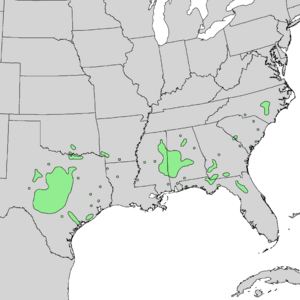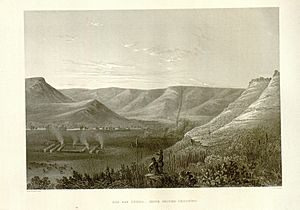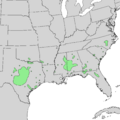Bigelow oak facts for kids
Quick facts for kids Bigelow oak |
|
|---|---|
 |
|
| Pressed specimen of Quercus sinuata var. breviloba collected by Elihu Hall on a rocky slope in Austin, Texas, on May 20, 1872. From the U.S. National Herbarium collection | |
| Scientific classification | |
| Kingdom: | |
| (unranked): | |
| (unranked): | |
| (unranked): | |
| Order: | |
| Family: | |
| Genus: | |
| Section: |
Quercus
|
| Species: |
Q. sinuata
|
| Binomial name | |
| Quercus sinuata var. breviloba (Torr.) C.H.Mull.
|
|
 |
|
| Combined natural ranges of Quercus sinuata var. breviloba and Quercus sinuata var. sinuata. | |
The Bigelow oak (scientific name: Quercus sinuata var. breviloba) is a type of oak tree. It grows in the southern United States and northeastern Mexico. People also call it shallow-lobed oak, white shin oak, or shortlobe oak.
Sometimes, the name "bastard oak" is used for this tree. Other names like "scrub oak" or "shin oak" can be confusing. This is because they refer to many different low-growing oak types. To be clear, American Forests uses "Bigelow oak" for Quercus sinuata var. breviloba. This variety often grows in groups of connected trees.
Contents
What's in a Name?
The scientific name Quercus sinuata var. breviloba comes from Latin. Quercus means "oak." Sinuata means "wavy" or "curved." This describes the wavy edges of the leaves. The "var." stands for "variety." Breviloba means "short-lobed." This refers to the short, rounded lobes on the leaves.

The common English word "oak" comes from old German and English words for the tree. The "Bigelow" part of the name honors John Milton Bigelow. He was a botanist who discovered this oak.
How It Was Discovered
John Milton Bigelow found the first Bigelow oak specimen. He collected it in a mountain area near Howard Springs in Crockett County, Texas. Bigelow studied plants in Texas, Arizona, New Mexico, and California.
About Its Scientific Classification
Plants are given scientific names to help scientists identify them. The Bigelow oak is a variety of Quercus sinuata. This means it's a specific type within the Quercus sinuata species.
Over time, scientists sometimes change how plants are classified. The Bigelow oak has had several different scientific names. But now, it is officially known as Quercus sinuata var. breviloba.
Mixing with Other Oaks
Sometimes, the Bigelow oak can mix with other oak species. When it mixes with the Post oak (Quercus stellata), they create a new type of oak. This mixing is called hybridization. The new hybrid oak is named Quercus × macnabiana nothovar. mahonii.
What It Looks Like
The Bigelow oak can grow up to 12 meters (about 39 feet) tall. Its trunk can be about 81 centimeters (32 inches) wide. The bark is gray and tends to flake off.
Its leaves are usually 3–8 centimeters (1.2–3.1 inches) long. They are 2–4.5 centimeters (0.8–1.8 inches) wide. The tips of the leaves are rounded and do not have bristles. The leaves can be shaped like a narrow oval or wider at the top. The twigs are smooth or have a few scattered hairs. The underside of the leaves has tiny, star-shaped hairs.
The acorns of the Bigelow oak are stalkless. They grow alone or in pairs. The acorn cup is shaped like a flattened hemisphere. The acorns themselves are somewhat oval-shaped with a blunt or rounded tip.
Growing in Groups
One special thing about the Bigelow oak is how it grows. Unlike some trees that grow as single plants, many Bigelow oaks form clonal colonies. This means a group of trees are all genetically identical. They come from one original plant.
A clonal colony starts from a single acorn. After it sprouts, the plant grows by sending out underground roots. These roots then send up new stems. These new stems are called ramets. A colony can look like many small trees or shrubs. But they are all connected by the same root system. They are all part of one big plant.
These groups of Bigelow oaks can cover large areas. They might grow up to five meters (16 feet) tall. Clonal colonies are more common where the soil is light or if the roots have been disturbed.
The word "shin oak" comes from a French word, chênerie. This word means "oak grove." It refers to these thickets of oaks. It doesn't mean the trees are "shin high."
Where It Grows
The Bigelow oak mainly grows in central Texas. It also grows in the northern Mexican states of Coahuila, Nuevo León, and Tamaulipas. You can also find smaller, separate groups of these trees. For example, they grow in the Arbuckle Mountains of south-central Oklahoma. Another group is found in Custer County, Oklahoma, near Foss, Oklahoma.
National Champion Tree
The biggest known Bigelow oak in the United States is a "national champion." It was added to the National Register of Champion Trees in 2017. This amazing tree is in Travis, Texas.
It was measured in 2017. Its trunk was 124 inches (about 3.1 meters) around. The tree was 46 feet (about 14 meters) tall. Its branches spread out 78 feet (about 23.8 meters) wide. The champion tree scored 190 points using the American Forests scoring system.
Images for kids
-
"Rio San Pedro—Above Second Crossing" (Devil's River, Texas), engraved by James David Smillie after a sketch made in the field by Augustus Guy de Vaudricourt no later than 1851. This illustration appears in The Report on the United States and Mexican Boundary Survey made under The Direction of the Secretary of the Interior, published 1857. De Vaudricourt and John M. Bigelow were civilian members of the survey party depicted in de Vaudricourt's contemporaneous drawing. Bigelow discovered Quercus sinuata var. breviloba in a gorge located between Devil's River and the Pecos River in what would become Crockett County, Texas.
-
No images depicting John Milton Bigelow are known to exist. For more than two decades, Bigelow corresponded with botanist John Torrey, who received and described many of the specimens Bigelow collected as a member of the United States and Mexican Boundary Survey between 1848 and 1855. This signature is reproduced from his letters to Torrey.





